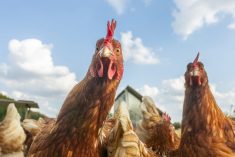A livestock marketplace in which a few large corporations “heavily influence” both the farm gate and retail prices paid for livestock and meat have led to the collapse in returns to livestock producers, the National Farmers Union said Tuesday.
The rising value of the Canadian dollar against U.S. currency is “just a small factor” in the larger equation, said NFU president Stewart Wells, who farms at Swift Current, Sask.
“In the mid-1990s, farmers got 60 cents a pound for beef, while packers and retailers took a dollar,” Wells said in a release, citing average prices for ground beef compared to prices per pound for D1 and D2 cows in Ontario during the same time frame. “Now farmers get 35 cents and packers/retailers get almost $2.50 a pound.
Read Also

U.S. livestock: Cattle strength continues
Cattle futures on the Chicago Mercantile Exchange were stronger on Friday, hitting fresh highs to end the week.
“Pork is no different,” he added, citing the average price for pork chops compared to Ontario prices per pound for Index 100 hogs, dressed. “Since 1976 the retail price of pork chops has risen from just under $2 a pound to between $4 and $5. Meanwhile the dressed hog price received by farmers has declined.”
In the short term, the NFU said, emergency measures are needed to get farmers through this crunch. Investment needs to be targeted to farmers, in particular family cow-calf and sow barn operations, the group said.
“Government is going to need to invest in primary livestock producers, just as it has done in automotive, forestry, mining and oil production,” said NFU board member Grant Robertson of Paisley, Ont., in the release.
At the very least, Robertson said, farmers’ costs of production must be met, along with a floor price program similar to what Quebec farmers have.
Longer-term solutions are to restore farmers’ market power and put limits on the economic power of big companies, Wells said.
Cargill’s third-quarter profit as of the end of August rose 83 per cent to $917 million compared to the same quarter one year earlier, he noted as an example, and the company’s profits set a record last year at $2.3 billion.
“This profit is coming at the expense of farmers,” Wells said.


















